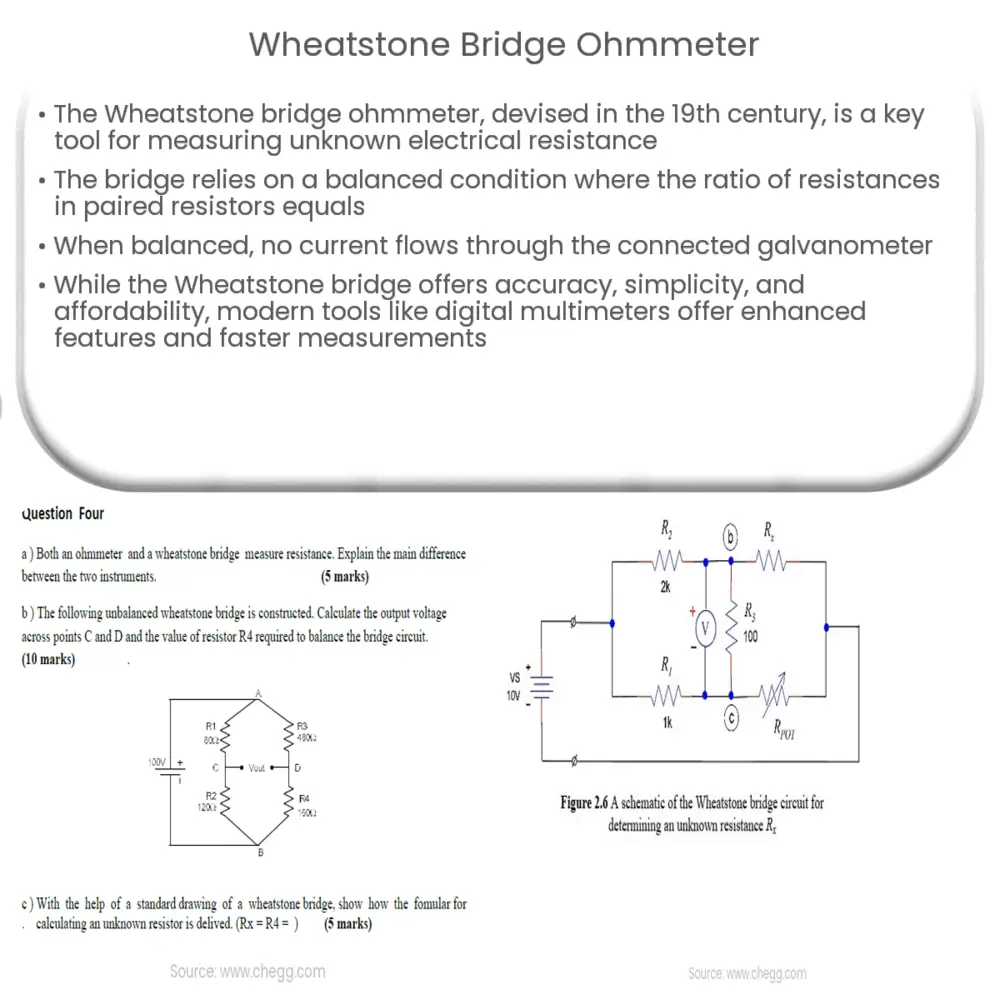The Wheatstone bridge ohmmeter is a classic tool for accurately measuring electrical resistance, using a balanced bridge of resistive elements.

Wheatstone Bridge Ohmmeter: The Classic Tool for Measuring Resistance
The Wheatstone bridge ohmmeter is a classic and indispensable tool in electrical engineering and physics for measuring unknown electrical resistance. Developed in the 19th century by Sir Charles Wheatstone, the Wheatstone bridge has been the go-to method for accurate resistance measurements ever since. In this article, we will discuss the principles behind the Wheatstone bridge, its components, and how to use it for measuring resistance.
Principles of the Wheatstone Bridge
The Wheatstone bridge is an arrangement of four resistive elements connected in a diamond shape, with a galvanometer or null detector connected across its diagonal. The main principle behind the Wheatstone bridge is the balanced condition, which occurs when the ratio of resistances in one pair of resistors is equal to the ratio in the other pair. In this condition, no current flows through the galvanometer, indicating a balanced bridge.
Mathematically, the balanced condition can be expressed as follows:
R1 / R2 = R3 / R(x)
Where R1, R2, and R3 are known resistances, and R(x) is the unknown resistance. By manipulating this equation, we can determine the value of R(x).
Components of a Wheatstone Bridge
A typical Wheatstone bridge ohmmeter consists of the following components:
- Four resistive elements (R1, R2, R3, and R(x)): As mentioned earlier, the bridge contains four resistors connected in a diamond shape. Three of these resistances are known, while the fourth is the unknown resistance that needs to be measured.
- A galvanometer or null detector: This sensitive instrument is connected across the bridge’s diagonal to measure the current flowing through the bridge. In a balanced condition, no current flows through the galvanometer, indicating that the correct value of the unknown resistance has been found.
- A power source: The Wheatstone bridge requires a power source to establish a voltage across the resistive elements, which in turn generates a current through the bridge. This is usually a battery or a DC power supply.
- A variable resistor or potentiometer: One of the known resistances, typically R2, is made variable to adjust the bridge’s balance. By changing R2’s value, we can achieve the balanced condition and determine the value of the unknown resistance.
Using a Wheatstone Bridge Ohmmeter to Measure Resistance
To use a Wheatstone bridge ohmmeter for resistance measurement, follow these steps:
- Connect the Wheatstone bridge circuit as described above, with the unknown resistance R(x) in one of the arms.
- Turn on the power source to establish a voltage across the bridge’s resistive elements.
- Adjust the variable resistor R2 until the galvanometer reads zero or the null detector indicates a balanced condition.
- Use the balanced condition equation to calculate the value of the unknown resistance R(x).
Advantages and Disadvantages of the Wheatstone Bridge Ohmmeter
There are several advantages and disadvantages associated with the Wheatstone bridge ohmmeter, which are discussed below:
Advantages
- Accuracy: The Wheatstone bridge provides highly accurate resistance measurements, making it a preferred choice for precise applications.
- Wide range of resistance values: The Wheatstone bridge can measure a broad range of resistance values by simply adjusting the known resistances and using different scales on the galvanometer or null detector.
- Simple and cost-effective: The Wheatstone bridge is relatively simple to construct and does not require expensive equipment or components, making it an affordable option for resistance measurement.
Disadvantages
- Manual operation: The Wheatstone bridge requires manual adjustment of the variable resistor to achieve a balanced condition, which can be time-consuming and prone to human error.
- Not suitable for low-resistance measurements: The Wheatstone bridge’s accuracy can be affected when measuring low resistance values, as the bridge’s sensitivity is limited by the galvanometer or null detector’s sensitivity.
- DC power source required: A stable DC power source is needed to ensure accurate measurements, which may not always be readily available or convenient to use.
Modern Alternatives to the Wheatstone Bridge Ohmmeter
While the Wheatstone bridge ohmmeter remains a classic tool for resistance measurement, there are modern alternatives that offer additional features and benefits:
- Digital multimeters (DMMs): DMMs are versatile, handheld devices that can measure a variety of electrical properties, including resistance. DMMs offer the advantage of automatic range selection, high accuracy, and faster measurement times compared to the Wheatstone bridge ohmmeter.
- Four-wire resistance measurement (Kelvin method): This technique involves using two separate pairs of leads to connect the measuring device to the resistor, eliminating the effect of lead resistance on the measurement. This method is particularly useful for measuring low resistance values with high accuracy.
- Resistance meters: These specialized instruments are specifically designed to measure resistance and often include features such as temperature compensation, automatic range selection, and data logging capabilities.
Conclusion
The Wheatstone bridge ohmmeter is a classic and essential tool for measuring resistance with high accuracy. Its simple design, cost-effectiveness, and wide range of measurable resistance values make it a popular choice for many applications. However, modern alternatives such as digital multimeters, four-wire resistance measurement, and dedicated resistance meters offer additional features and benefits that may be more suitable for certain applications. The choice of the most appropriate resistance measurement method depends on factors such as accuracy requirements, available resources, and the specific application at hand.

